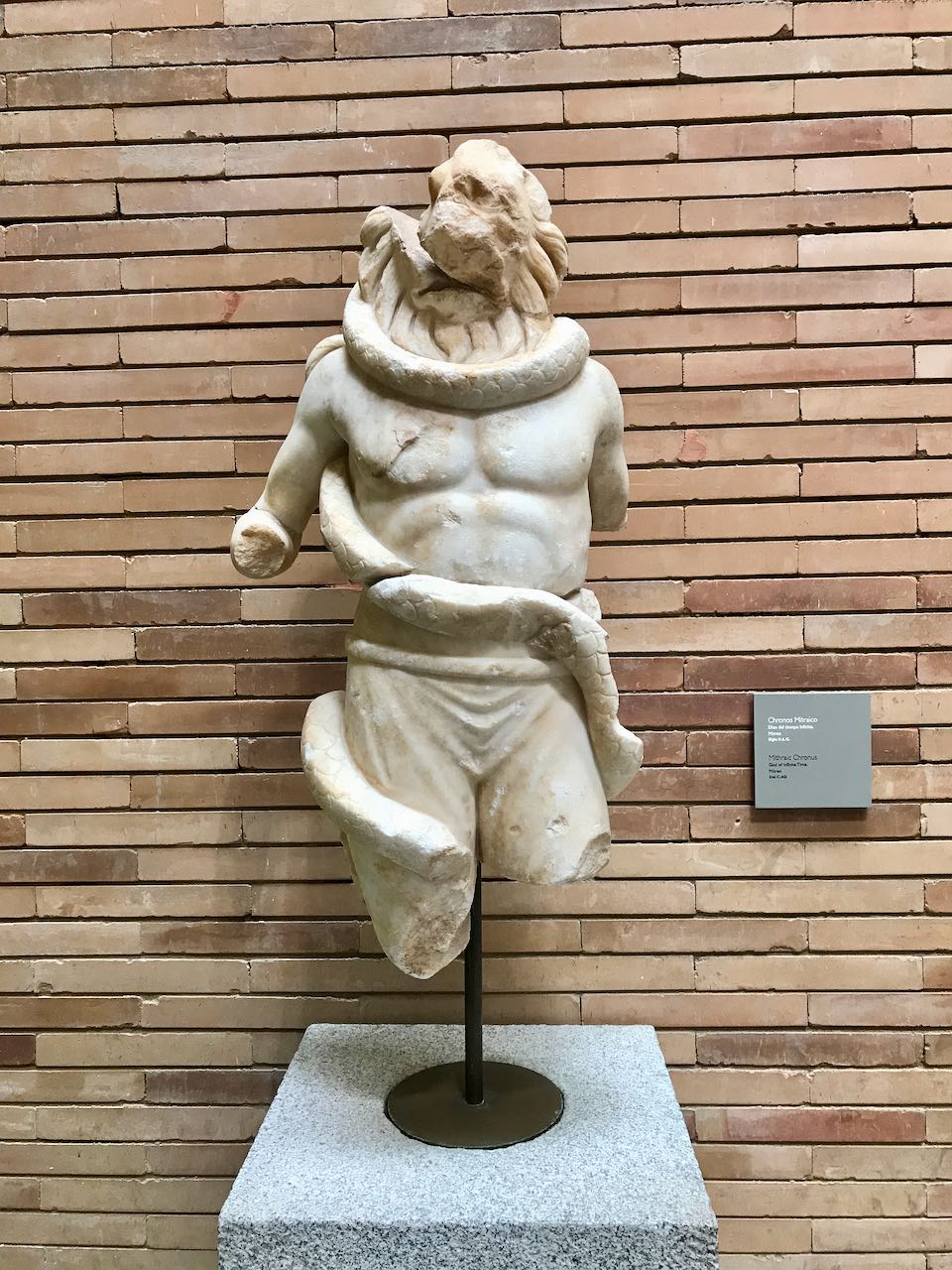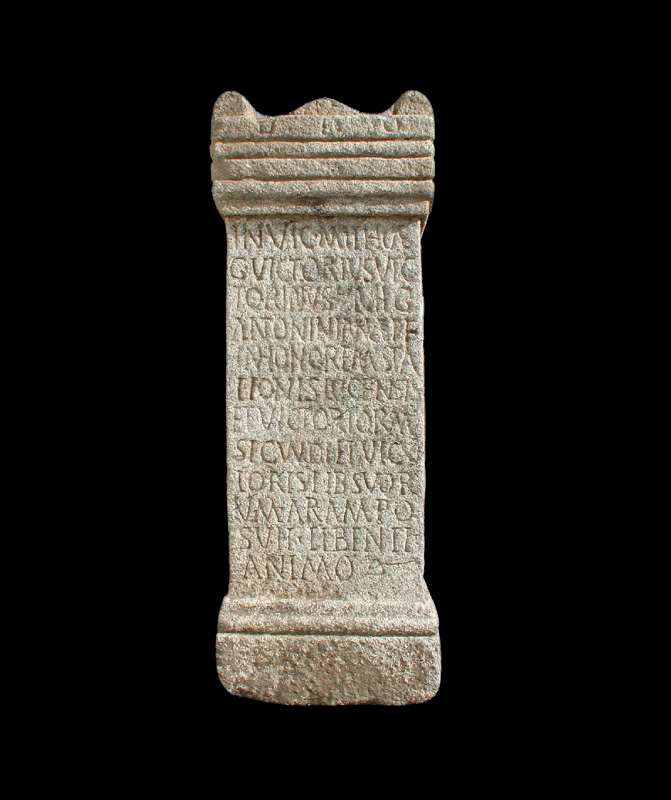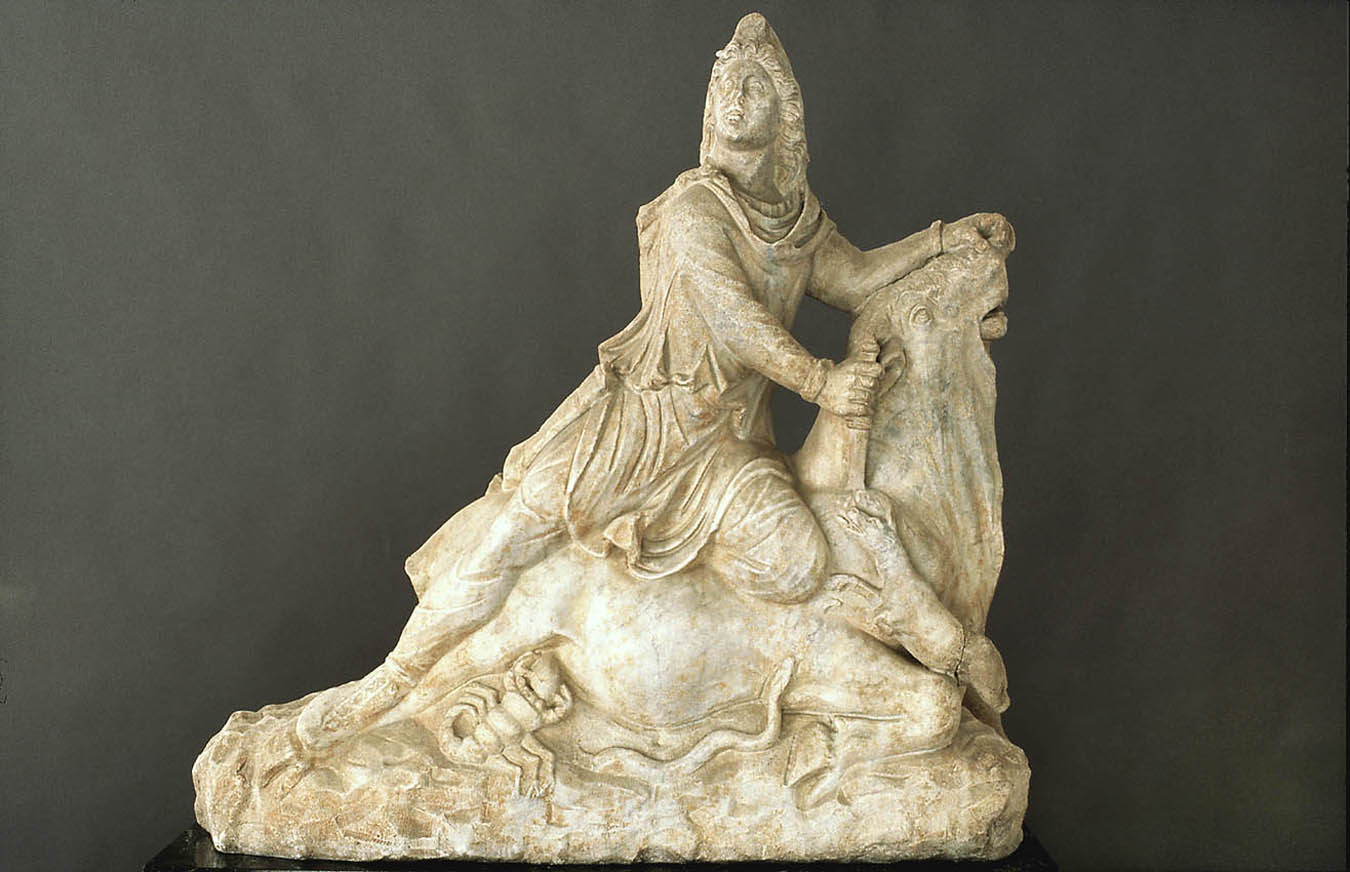Mithras in Hispania

Jaime Alvar in Çanakkale, Turkey.
Rosana Triviño
Jaime Alvar has set the standard with his trilogy on the cults of Mithras, Isis, Magna Mater and Atis in Hispania. His work is now essential for understanding this phenomenon in the Iberian Peninsula and, by extension, the Roman Empire.
Alvar also makes us reflect on the foundations of contemporary Spain: ’We Spaniards are the heirs of Rome, but with brutal contradictions,’ he states and justifies.
What is the first evidence of the Mithraic cult in Hispania?
At the end of the 1st century AD, we have the supposed Mithraeum on Espronceda Street in Mérida, which apparently ceased to function at the beginning of the following century. If we accept this chronology, it would be one of the oldest in the whole Empire, which is difficult to assume.
Then there is a hiatus until 155, the year to which the altars and sculptures found during the construction of the bullring on the hill of San Albín belong. No architectural remains were found there, but they undoubtedly came from the alleged Grand Mithraeum of Merida, which has not yet been discovered.
If the so-called Mitreo de la calle Espronceda is not a temple, what is it?
I interpret it as a hiding place. Someone took the trouble to bring statues, probably from different shrines, and collected them in the villa, from where they never left until modern times. Something happened that caused them to be hidden. Two sculptures are noteworthy in this respect.
The first is the lion-headed Aion, with a blow to the face. There is no desire for viciousness. Someone just hit him with a sledgehammer, smashing his face and thus removing the possibility of communication with the divine power. Someone has desacralised him. He has annulled him. There is a clear will to do this.
Aion of Mérida
The New Mithraeum / Andreu Abuín (CC BY-SA)
Other sculptures may be decapitated, but that means nothing. Sculptures break. In fact, in the tauroctony of Cabra, the cloak of Mithras and the tail of the bull are missing. Where are they? Maybe they are over there. Perhaps someone has taken them away to make lime. We can speculate ad infinitum, but we cannot say what happened.
But the curious thing is that Ana María Rodríguez Azcárraga, in the collections of the Museum of Mérida, found sculptural fragments belonging to a tauroctony. The relief had been crushed. In other words, someone had taken the trouble to smash it.
So we have a smashed tauroctony and the lion-headed god. The two most important monuments of the Mithraic cult were vandalised, while the others, more common in polytheism, did not suffer similar aggression.
Something happened in Merida. This is my opinion. Moreover, after the destruction of the Tauroctony, someone else collected the fragments and put them all together.
It is very remarkable. All the decoration, all the statues, all the epigraphy is from that time, but nothing beyond that. There is no material from the end of the 2nd century. There is nothing from the beginning of the 3rd century and suddenly we find voluntary destruction.
Let’s look for a culprit. Was it the Christians? In the 2nd and 3rd centuries there was no Christian community powerful enough to smash the polytheistic statues, especially the Mithraic ones.
During the 3rd century the cult of Mithras disappeared. We do not have a single document confirming the maintenance of the cult, which makes a Christian attack difficult in, say, the 4th or 5th century. Nor does it explain why anyone would go to the trouble of hiding statues of cults long since abandoned.
What happened?
There was an iconoclastic outburst. We know nothing more. Nor do we know when the deposition on the hill of San Albin took place. What is clear is that San Albin is not a place of worship. It is a place of concealment.
In other words, a group of non-Christians went on a rampage against the Mithraic cult in Mérida?
We can’t say for sure, but it is very significant that among the many sculptures, the two most representative of the Mithraic cult are the most mutilated. And of course I think it could have been the work of Christians. Yes, but it is a hypothesis. I can’t prove it. We lack chronological information and without it it is not possible to propose a plausible account, only suppositions.
What happened during the whole of the 3rd century that no one left evidence of their connection with Mithras? There is no cultic element in the whole of Hispania later than the monuments of Mater Magna in Cordoba, from 238. Of course a Mithraic sanctuary could have survived in Mérida. People could get to know a place of deep antiquity, and later the Christians came and destroyed it. Or not.
We don’t know whether there was worship there or not at the time when the Christians destroyed it. What is certain is that there were polytheists who took it personally and decided to preserve it on the hill of San Albín.
What can we say about the testimony of Lugo?
It dates from the year 213. A unique testimony is that of Gaius Victorius Victorinus. A centurion stationed in Lucus Augusti who built a mithraeum dedicated to his two freedmen? To his freedmen and to the statio lucense, that is, to the military detachment stationed there.
Granite altar dedicated to Mithras
Museo Universitario A Domus do Mitreo
Let’s play with hypotheses. Perhaps the freedmen played an important role in introducing Victorinus to the Mithraic cult, and Mithraism in turn helped to give him the auctoritas necessary for the soldiers of the statio to bind themselves to him with ties other than strictly military ones. This may well be the case, but Victorinus was going against the grain, since there was almost no religious epigraphy in Hispania at the time.
A few years earlier, the senator Calpurnius Rufinus had gone to a remote rock sanctuary in Portugal, in Tras-os-Montes, and adapted it to a mystery ritual dedicated to Serapis, with testimonies in Greek... And at the beginning of the 3rd century, some lords of the ordo equester appeared in Austurica Augusta and built an altar to Apollo, Nemesis, Isis, Serapis and I don’t know how many other gods.
And the commander-in-chief of Legio VII, in Leon, makes an inscription to some equally exotic gods. And in Cordoba, someone promoted the cult of Mater Magna by donating several altars to the Empire in 234 and 238.
All these imperial agents intervened to promote polytheism in the transition from the 2nd to the 3rd century. There was a clear intention to promote certain cults in order to encourage a weakened cohesion.
This was an operation that began at the end of the Severan period, but even so, from the 230s there is no religious epigraphy in the Iberian Peninsula. It disappears.
Did people stop believing in the gods?
No, the ritual just changed. Now there is no killing of animals, no sacrifice. There is no need to erect altars.
Why only in Hispania?
I can’t hypothesise because we have no documentation of this phenomenon. There is none. There are no Christians. Christianity is still a century and a bit away from being established.
Christianity has nothing to do with the decline of paganism in the Iberian Peninsula. I cannot make a hypothesis without a documentary basis. I would be making up a fiction.
I know that something drastically changed in Hispania in the middle of the 3rd century, because people no longer felt the need to go to the lapicide’s workshop to commission a votive altar. And the workshops closed. For this reason, the little later epigraphy that we do find is generally of poorer quality. It has fallen into disuse.
Then we have the Els Munts Mithraeum with specific problems. That’s all there is. That is why the Mithraeum of Cabra is so important. Moreover, the Cabra Mithraeum gives us an additional indication of the presence of mithraea in domus, as opposed in public spaces. The mithraea in Hispania are of a private nature. In Lugo and Cabra. And also in Els Munts, although it is probably an imperial villa.
Mitra de Cabra (Códoba)
Museo Arqueológico y Etnológico de Córdoba
So do we take the Els Munts Mithraeum for granted?
No epigraphic or statuary evidence has been found, but the space corresponds to the structure of a mithraeum, although it measures more than thirty metres. The only ones we know of of such dimensions are the one in the Baths of Caracalla and the one in Mainz, which was destroyed after being excavated. But thirty metres is a lot of metres for a mithraeum, and especially for a mithraeum in a villa.
Let’s return to Baetica. Before the discovery of the Mithraeum of Cabra, several other sites had been associated with the cult of Mithras. What’s new?
In Fuente Álamo, a site was found that was thought to be compatible with a mithraeum. I did not remove it from the catalogue out of caution, but at this point, out of prudence, I would remove it. I don’t think that Fuente Álamo is a mithraeum, because there is nothing to support this hypothesis. There are not even benches. It was assumed that there could have been mobile benches, made of wood, but it cannot be assumed what is missing to affirm that it was a mithraic space.
The hypothesis that the Elephant Tomb is a mithraeum is an extravagance. It is neither a mithraeum nor a sanctuary of Mater Magna. Archaeoastronomy makes it possible to establish significant realities that are often compatible with different cults. In other words, the fact that the sun hits the back of the tomb at certain times of the year does not prove that it is a mithraeum. Is it significant? Well, it could be, but also for a funerary cult unrelated to Mithraism.
We all have prejudices and interpret facts as we see fit. If a temple faces east and the sun’s rays enter at the summer solstice, that’s the most normal thing in the world, but it doesn’t necessarily have to be associated with Mithraism.
So what is the reason for saying that a tomb is a mithraeum? Tell me, in all the wonderful inventory of The New Mithraeum, how many mithraea have you found in a tomb?
This would be the only one.
There is no other example in a necropolis. But if we think of Mithraism as a religion of salvation... Another one of those buzzwords that have fallen into disuse: oriental, esoteric, mysteric and salvation religions. Since Mithraism is supposed to be a religion of salvation, the cult of the dead must somehow be connected to Mithraism. And we turn a tomb into a mithraeum. If there really was an intention of salvation in Mithraism, why is there no Mithraic epigraph linked to salvation? It appears in Christianity, does it not? But not in Mithraism, nor in the cult of Isis or the cult of Mater Magna.
I think we need to be more rigorous. The first hypothesis is still the most accurate. The Elephant Tomb of Carmona is probably the seat of a funerary college.
In short, a mithraeum in Mérida, one in Cabra, another in Lugo and yet another in Els Munts. Not much, don’t you think? Is there not enough investment in archaeology in Spain? Is there no interest?
But come on, who wouldn’t want to have a mithraeum in their town? Of course there’s interest!
Let’s take it one step at a time. During the Franco dictatorship, interest in the archaeological heritage was limited, that’s true. It is also a cultural phenomenon.
During the Franco era, the little that was invested in heritage was mainly in the heritage of the establishment, that is, of Rome. But we are the heirs of Rome, with brutal contradictions.
We are heirs of Rome, but at the same time Francoism justified Viriato, who would be a terrorist from the point of view of the order established by the state. The contradiction consisted in praising the imperial fasces on the one hand, and Viriato’s Spanishness on the other.
The very Spaniard Viriato would be the one who would end up blowing up Admiral Carrero Blanco in Claudio Coello Street. In other words, Viriato’s claim to Spanishness is at odds with the virtue of the imperial eagles who impose Hispanidad everywhere. And how is this to be digested from the point of view of the management of intangible heritage and identities?
This is the conflict between Francoism and the past. During the dictatorship, however, what was of interest was the imperial idea, and therefore first and foremost Rome.
With the transition came the State of Autonomies, and then the idea was to foster local specificities, to highlight regional differences. And for this, in the first 20 years of democracy, there was an enormous economic investment, managed by the autonomous regions. An investment that focused on protohistoric archaeology, to make it clear that Andalusia was Tartessian, Catalonia Iberian, Castile Vaccean or the Canary Islands Guanche.
And now we are in a moment of recovery of Roman archaeology.
Another different reality is that I believe that Mithraism is a fundamentally urban phenomenon, and most of the cities were inhabited later, so it is very difficult to find mithraea. We find them by chance.
Many mithraea have been found in Rome, it is true, but according to Filippo Coarelli there must have been about a hundred and we know of only a dozen or so. In other words, the loss rate is brutal. If there were four in Mérida and we have found one and a half, we are not doing that badly. In Lugo we found one. I am convinced that there is another one in Tarragona.
What we have is scarce, but significant, because Mithraism was not a mass cult either.
Romanising Oriental Gods. Myth, Salvation and Ethics in the Cults of Cybele, Isis and Mithras has been published in English by Brill.
Alvar’s trilogy on the Egyptian cults, Mithras, Mater Magna and Atis in Hispania has been published in Spanish by Dykinson Editorial in association with Presses universitaires de Franche-Compté.
Los cultos de Mater Magna y Atis en Hispania
El culto de Mitra en Hispania
Los cultos egipcios en Hispania



Comments
A chara,
Any chance of an English translation of El Culto de Mitra en Hispania? If all else fails I’ll work my way slowly through it with my diccionario. Meanwhile, I’m struck by some similarities between the Mithraic Mysteries and Irish Druidism, particularly the tairbhfeis roughly translated as the "bull feast" or "bull sleep". The slaughter of a bull was involved. Rites of kingship applied but also when in search of visions, the Druid/Druidess would wrap themselves in a bull hide and sleep within the dark caves of the ancient mounds (built pre Druidic religion). Many of the mounds were constructed to face the sun. The mound at Brugh na Boinne has a ’roof box’ over the entrance which allows for the sun’s rays of the winter solstice to strike the central chamber. O.R.
The so-called Elephant Tomb was not a tomb. The data that support its character as a mithraeum derive from its formal characteristics: A room divided into three parts, presided by a chapel, subway, with a water fountain. These are characteristics that formally define a mithraeum. In addition, it has a window that directs the sun's rays into the center of the chamber at the equinoxes three hours after sunrise. In spring, at that time, Taurus would emerge over the horizon. This same configuration is observed in Hawarte whose window allowed the sun's rays to point to the altar during the winter solstice, two hours before sunset. At that time, Taurus emerged over the horizon.
One cannot call a proposal extravagant just because one does not know the basic principles of archaeoastronomy or building archaeology.
Add a comment